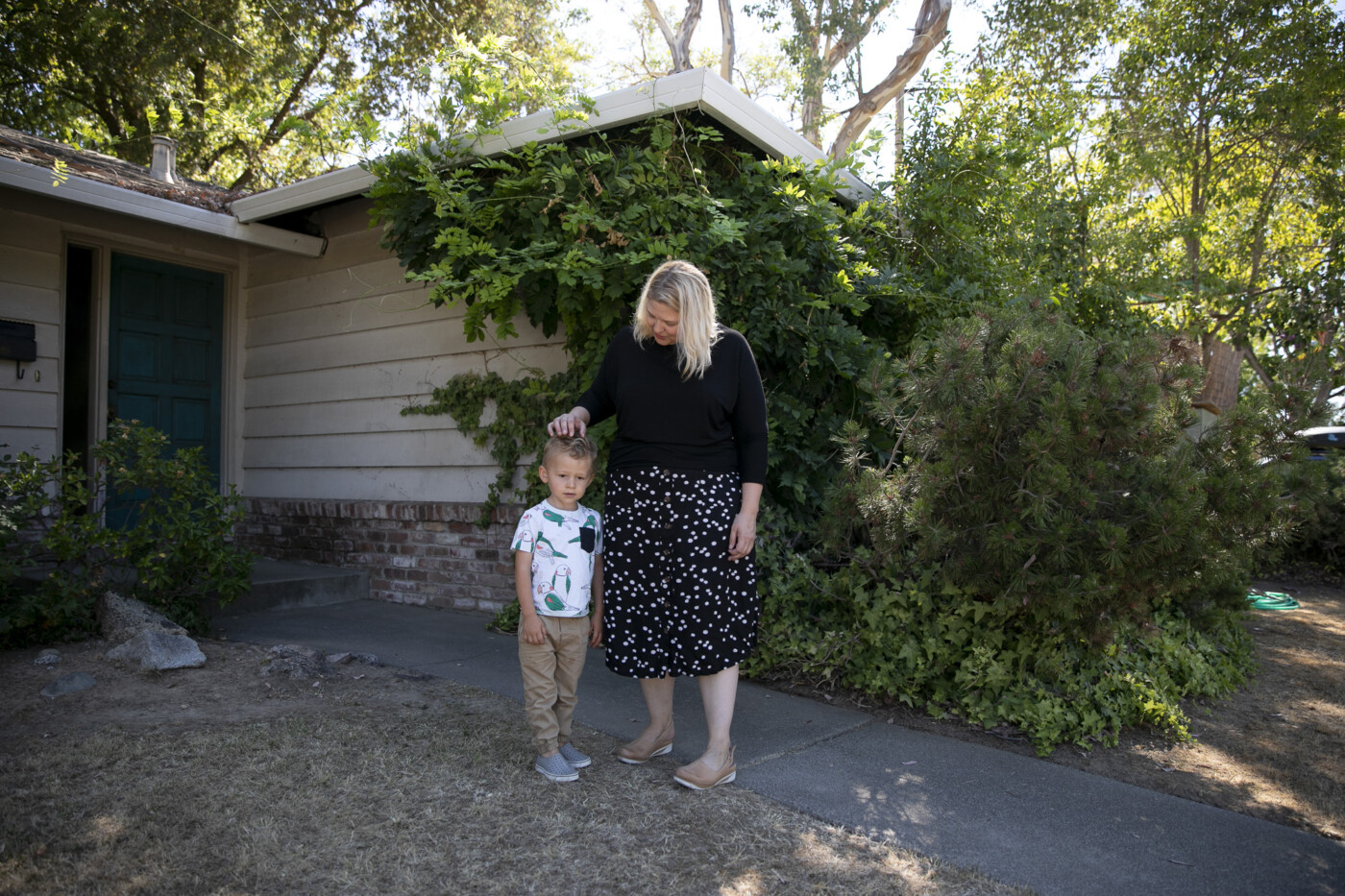On a few of the vast, verdant lawns in East Sacramento, one of the capital city’s most popular and expensive neighborhoods, yellow-and-black yard signs urge passersby to “save neighborhoods” and keep Sacramento “livable and diverse.” The message symbolizes a big battle taking place at the state Capitol only a few miles away — whether to do away with sacrosanct single-family neighborhoods to address the California housing crisis.
Senate Bill 9, one of several measures alluded to by the signs, would technically allow as many as two duplexes, two houses with attached units, or a combination — capped at four units — on single-family lots across California, without local approval.
On Sept. 16, two days after winning the recall election, Gov. Gavin Newsom signed the bill into law, despite pleas from cities to veto it.
“The housing affordability crisis is undermining the California Dream for families across the state, and threatens our long-term growth and prosperity,” Newsom said in a statement. “Making a meaningful impact on this crisis will take bold investments, strong collaboration across sectors and political courage from our leaders and communities to do the right thing and build housing for all.”
The new law will allow more building where it’s now illegal, with the intent of reducing California’s fast-rising home prices and increasing access to homeownership through a greater variety of options, according to state Senate leader Toni Atkins, a Democrat from San Diego who introduced the bill and similar versions in the past.
To lessen concerns from more than 200 cities and neighborhood groups that oppose the bill, Atkins added a few amendments that give local jurisdictions some veto power over units that threaten public health and safety and curtail potential speculation. The bill — approved by the Senate in May and two Assembly policy committees in June — was approved by the full Assembly on Aug. 26 on a 44-16 vote.
Supporters, decrying “mistruths” by opponents that the bill would end single-family zoning, said the legislation would help ease the affordable housing shortage. Assemblymember Alex Lee, a San Jose Democrat, said young people like him are having to give up their dream of homeownership.
In a statement after the vote, Atkins thanked Assembly Speaker Anthony Rendon in particular. “This bill is about opening the door for more families to pursue their version of the California Dream — whether that means building a home for an elderly parent to live in, creating a new source of income, buying that first house, or being welcomed into a new neighborhood. It’s about giving parents the chance to pass on wealth to their children and giving neighbors the chance to make our communities more inclusive,” she said.
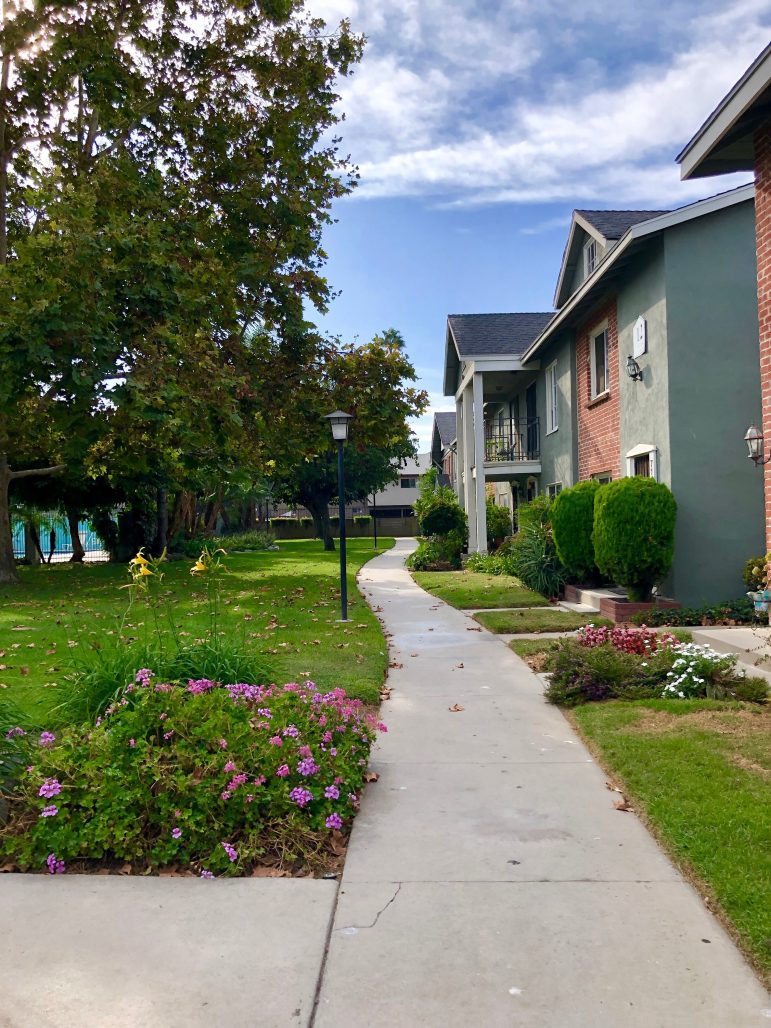
On Aug. 30, the Senate voted 28-7 to concur on the amendments and send the bill to Newsom’s desk.
After Newsom signed the bill, the League of California Cities decried what it called a “top-down mandate” from “flawed legislation” that “undermines the ability of local governments to responsibly plan for the types of housing that communities need, circumvents the local government review process, and silences community voices.”
“Even worse, there are no provisions in SB 9 that require new housing to be affordable, continuing the cycle of the construction of new units that are out of reach for many working-class families,” Carolyn Coleman, the league’s CEO, said in a statement.
After the Assembly vote, a group calling itself Californians for Community Planning Initiative immediately filed a proposed constitutional amendment for the November 2022 ballot to reassert local control over zoning and land-use decisions in opposition to the bill.
But some analysts say the linchpin of the Senate’s housing package would probably have a negligible impact on the California housing crisis, at least in the short-term. As for the nightmare scenario described by opponents? There simply isn’t enough evidence to back that up, either.
That’s because a change to zoning means very little in reality, starting with the number of units that would actually get built, these analysts say.
Development would be realistic in only about 410,000 parcels in California at most, or 5.4% of land now occupied by single-family houses, according to a new study by the Terner Center for Housing Innovation at UC Berkeley based on the version of the bill without the new amendments.
That could add a total of 700,000 new units across California, if every single homeowner for whom the change made sense chose to develop. “Overall, that’s a sliver of the 7.5 million single-family homes throughout the state,” said David Garcia, policy director for the Terner Center.
One of the new amendments — which requires owners to live in the home for at least three years after they split their lots and build as many as four units — cuts the potential total of new units by 40,000, or 6%.
The analysis was conducted using current land values and development costs, so the number of feasible units could change. But Garcia said that was unlikely in the near-term. The study found that the typical property owner could not afford to build a second unit, much less a third or fourth. Other barriers: The new split lot couldn’t be less than 1,200 square feet, and historic districts, fire hazard zones and some rural areas would be barred from development.
“You would not see the wholesale bulldozing of single-family homes, as we’ve seen characterized in many of the public comments in committee hearings,” Garcia said. “There’s just no financial basis for that fear.”
Single-family zoning, which SB 9 seeks to eliminate, has deeply racist roots. Originally introduced in Berkeley in 1916, the designation was used to block a Black-owned dance hall from moving into a primarily white neighborhood. The zoning not only precluded the dance hall, but also multifamily units more commonly occupied by people of color.
Single-family zoning was quickly adopted by cities across the United States. So to many California housing advocates, eliminating what they call “exclusionary zoning” is a symbolic and necessary act.
“This is about getting rid of symbols of segregation and racism,” said Kendra Noel Lewis, executive director of Sacramento’s Housing Alliance, which supports a similar local zoning change to allow duplexes, triplexes and fourplexes throughout the city.
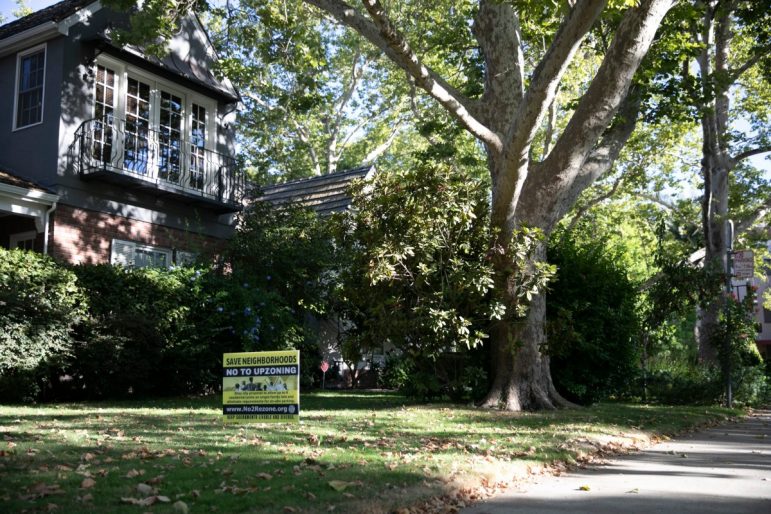
The “save neighborhoods” signs in Sacramento’s wealthier neighborhoods are frustrating to Lewis because “white folks have no problem telling other people what to do,” she said.
Many critics of the bill — including Livable California, a group that supports single-family neighborhoods and local control — emphasize that the legislation doesn’t require that any units be affordable or capped at a certain price. So it would only really benefit wealthy people and developers, they say.
The bill’s supporters push back by asking: Where are neighborhood groups during battles over affordable housing projects? Often on the opposing side.
While there aren’t any units set aside for the lowest earners, the bill’s backers say that market-rate housing ultimately helps create affordability for everyone. By adding a unit that a middle-class family can afford, it opens up a less expensive unit for a family one step below them on the economic ladder.
“There’s this chain effect across the housing market, sort of like a game of musical chairs, where you just start adding chairs,” said Louis Mirante, legislative director for California Yes In My Backyard, or YIMBY, one of the bill’s main supporters.
Adding a unit of housing in East Sacramento, for example, could mean that a middle-class white family moves there, instead of displacing another family in historically Black Oak Park, Lewis said.
Elizabeth Mae Olson, a white, 44-year-old single mother, grew up in the yet-ungentrified portion of Oak Park. Growing up, she said she shared various homes with rats and roaches. She can’t remember the number of times her family was evicted, and she was briefly homeless as a teenager. So when she moved to East Sacramento a few years ago, it was mostly because she wanted to feel safe and be close to lush, historic McKinley Park.
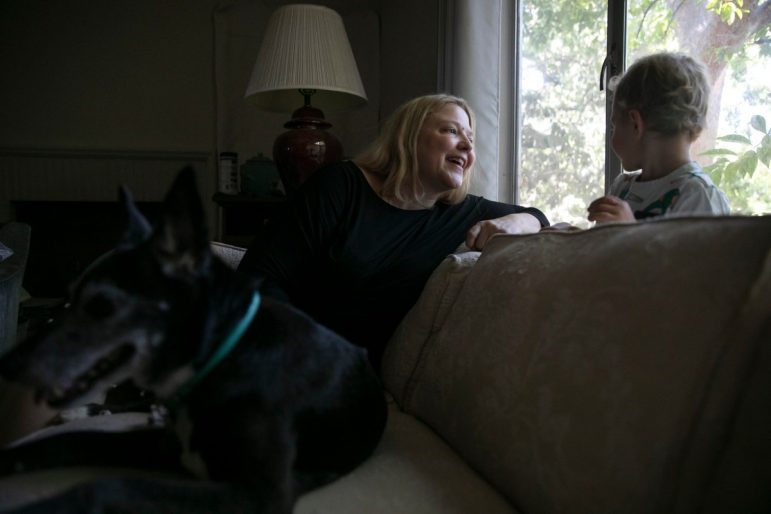
“The only reason I can even live in this neighborhood is because it’s a duplex,” she said. “I could not afford a single-family house in this neighborhood. No way, no how.”
Still, she pays $2,075 a month for her two-bedroom apartment, which a couple making minimum wage would be hard-pressed to afford, she says.
While duplexes are still legal across Sacramento on corner lots, the duplexes, fourplexes and even six-unit buildings that dot her block near the park were built prior to the single-family zoning ordinance that outlawed them.
Would adding more of those buildings now lower rents? While more market-rate housing on the regional level has indeed been found to lower prices over time, the jury is still out at the neighborhood level, explained Robert Wassmer, chairperson of Sacramento State University’s master’s program in urban land development.
But Wassmer, who also lives in East Sacramento, said the unspoken argument against the bill really revolves around property values in higher-end neighborhoods. And he found in a 2018 study the greater the number of occupants in a household, the lower the home values.
“They’re worried about their property values going down, and liberals can’t dismiss that. For many people, that’s their nest egg. That’s their retirement,” he said.
Critics of the bill, the majority of whom are homeowners, say their worries aren’t about wealthy, white neighborhoods. Rather, they say the legislation would likely affect mostly Black and Latino neighborhoods, where the land is cheap enough to build, and the potential rent or home prices are high enough to cover development costs.
A gentrification bomb?
Mangan Park, a small middle-class neighborhood in Sacramento, is one of the places ripe for displacement, says homeowner Jennifer Holden.
“We don’t live in fear of those other people moving in because we already are those people,” she said, pointing to the neighborhood’s mostly Asian and Hispanic demographics. “What would change is our way of life.”
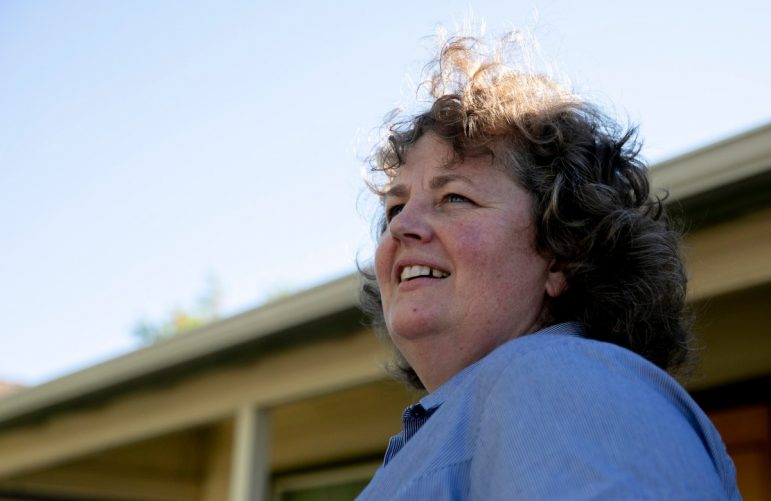
Holden, who is white, said she receives weekly flyers and phone calls asking that she sell her home — often to unnamed buyers. Speculative buying by corporate investment groups will only increase if more development becomes feasible in her neighborhood, she argues.
Chris Jones, an IT worker and Black homeowner in Colonial Heights in Sacramento, makes a similar argument. He worries that the lifestyle he currently enjoys — playing catch with his son in a private yard or parking in front of his home — would be in jeopardy if developers maxxed out potential property values.
“A lot of people aspire to homeownership,” he added. “If we overemphasize the building of dense living, that typically is not for ownership. It’s for renting.”
While the bill previously said it was up to cities to mandate that homes be occupied by their owners to undergo a lot split, the new amendment requires it statewide. The idea is to prevent speculation by corporate groups that have already bought up about 17% of the state’s housing stock.
Researchers who focus on gentrification and zoning say while concerns about displacement are valid, these zoning changes have happened in only a handful of places so there’s just not enough evidence to predict what would happen if this bill becomes law.
It’s “like trying to predict the path of a balloon in a tornado,” said Stephen Menendian, director of research at the Othering & Belonging Institute also at UC Berkeley.
And we’re likely to see gentrification, with new housing construction or not.
“Leaving neighborhoods so that they only allow single-family houses to be built essentially assures that no new housing will be built,” said Yonah Freemark, senior research associate in Metropolitan Housing and Communities at the Urban Institute. “So, it’s kind of a dead end as far as the strategy goes.”
Most state groups focused on racial and environmental justice have chosen to remain neutral on the bill because it doesn’t require affordable housing. While the concerns over gentrification may be valid, many hide behind that argument in bad faith, said Cynthia Castillo, a policy advocate for the Western Center on Law and Poverty.
“We feel that the equity conversation has been co-opted by folks that are only interested in producing market-rate housing,” she said. “And also by some of these other groups that aren’t traditional equity groups.”
A modest bump?
As their COVID-19 project last year, Jeff Harris and his teenage daughter removed the roof of the two-car garage behind his 32-year River Park home in Sacramento and added a 700-square-foot apartment.
Then came the complaints.
One neighbor, concerned about their privacy, asked that there not be any windows on one side. The real estate agent selling the property behind his also called to ask whether there would be any windows overlooking her clients’ yard “because that might kill the sale,” he said.
Harris isn’t only a homeowner, but the city council member representing East Sacramento, so the debates over the small addition to his backyard helped inform a much bigger discussion at City Hall: whether Sacramento, and now the state, should allow homeowners to build up to four units on their single-family lots. The City Council isn’t expected to vote on the zoning change until next spring, after months of community outreach.
Proponents argue it’s a modest jump: California housing law already allows as many as three units per single-family parcel — a main home, an accessory dwelling unit, like Harris built, and a junior accessory dwelling unit of as much as 500 square feet adjoined to the existing home.
But Harris says adding more than a single ADU is “extremely inconvenient and irritating to my neighbors.” And bringing several additional families into a lot could put a massive strain on the city’s infrastructure. Harris’ complaints echo those of 120 mayors and city council members from 48 cities and others about the bill: Zoning decisions should be local.
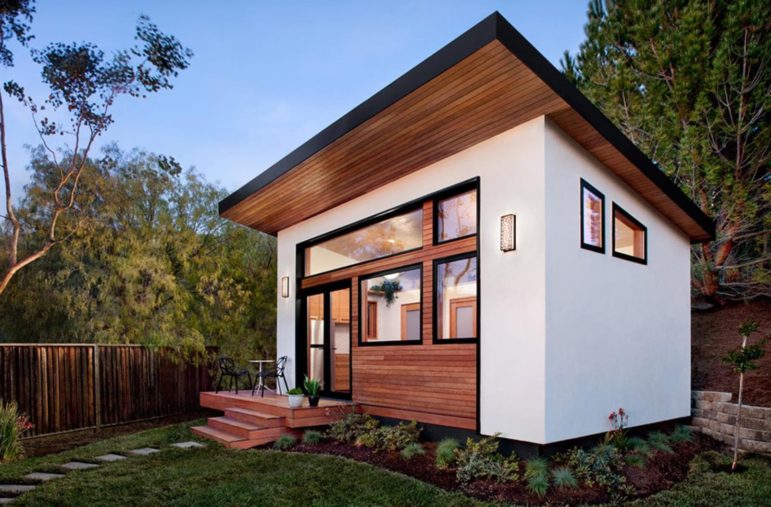
“How are we going to deal with the infrastructure upgrades? How are we going to mitigate parking? How are we going to collect the trash?” he asked. “And I can tell you, almost every city in California right now is broke.”
Olson, the single mother living in a duplex, echoes many of Harris’ complaints. The program manager of infectious disease prevention at UC San Francisco started paying close attention to the zoning debate when she bought a home in Land Park, another of Sacramento’s wealthiest, mostly white neighborhoods — something she never thought was possible.
It only happened because when Olson’s grandmother died, whose house she bought, she took the place of her dead father on the will, she says. Then her 80-year-old aunt stepped in with her portion of the inheritance, as did another uncle, adding up to just enough for a downpayment and for Olson to qualify for a mortgage. She closed on the house in late July.
And now, she’s considering renovating the dilapidated building into a duplex — only legal because the house sits on a corner — so that there’s room enough for her son, their dog and her aunt and her partner, who currently live in the house.
Once her aunt passes, Olson plans to rent out the second unit. She has mixed feelings about landlords, who “have always been the boogeyman for me,” she says. But it’s the only way she sees to eventually afford her son’s college tuition.
“When I die, my kid will have wealth,” she said. “That was never afforded to me. And it’s a game-changer.”
